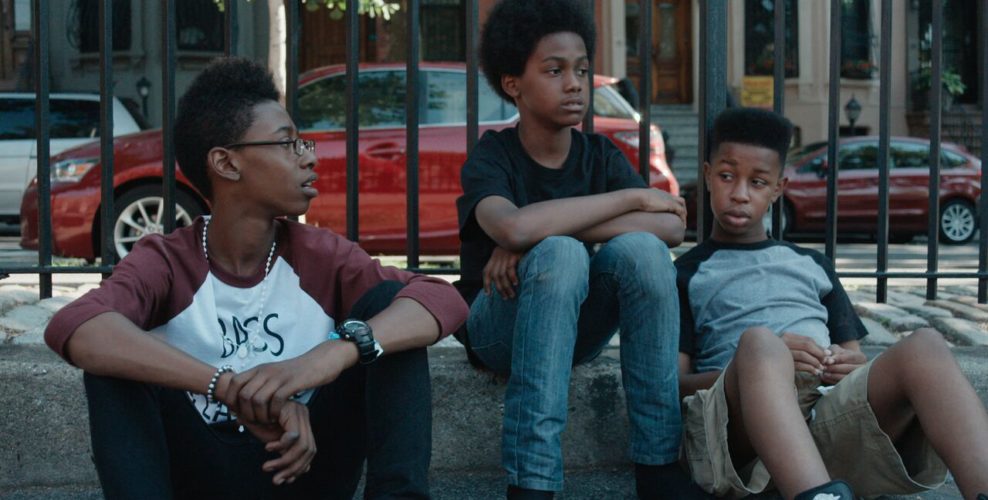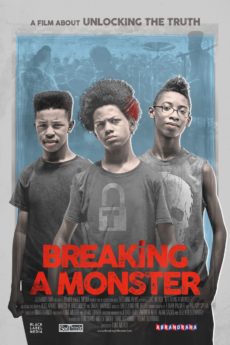 Luke Meyer’s film Breaking A Monster: Unlocking The Truth documents the making of an African American heavy-metal /speed-punk child band. If the esoteric premise isn’t the clincher, the group’s vertiginous talent and bruised but unbreakable spirit prove to be.
Luke Meyer’s film Breaking A Monster: Unlocking The Truth documents the making of an African American heavy-metal /speed-punk child band. If the esoteric premise isn’t the clincher, the group’s vertiginous talent and bruised but unbreakable spirit prove to be.
Bearing witness to Unlocking The Truth’s journey along the road to fame is comparable to rubbernecking. Somewhat guiltily, the viewer cannot look away as these youths are squeezed through the grinder of stage-parent micro-management, and later, through the predominantly white run Rockstar factory of the Music Industry. Thankfully, the end product is served up to often unexpected and original effect.
Documenting the subject of childhood celebrity itself, divorced even from considerations of racism, classism, and cultural appropriation so inherent to this film, risks churning out some pretty morally reductive fare. It has also been known to amount to mere marketing propaganda.
Instead, Meyer offers sharp elucidation balanced with delicate appreciation of the complexity of the issues at stake. Ultimately, his beautifully composed and edited think piece is delivered from as genuinely a fly on the wall perspective as is possible in our era of instant image making.
Consistently amusing, often bizarre and occasionally devastating, the action unfolds in harmony with the lens. Beneath, however, a redemptive underpinning persists; a flash of maturity in these wunderkinder, alongside their childish precociousness, that assuages any fear that these boys will ever be broken.
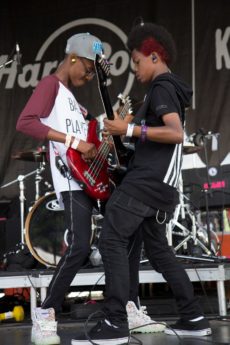 After filming, the plot reversed; the band walked away from a 1.8 million dollar Sony deal, releasing their first album under indie label TuneCore. Did you see it coming?
After filming, the plot reversed; the band walked away from a 1.8 million dollar Sony deal, releasing their first album under indie label TuneCore. Did you see it coming?
While we were filming, it was pretty clear that the band was growing increasingly frustrated about their contract. The primary problem was that they were unable to release any of their music. On the day that the movie premiered at SXSW, Alan (their manager) told us that they would be looking to end their relationship with Sony. It didn’t surprise us, but we thought the process would start later. As it turned out, Alan and the band announced that they were seeking an end to their contract in a BuzzFeed interview, moments before the premiere. So the announcement itself was a surprise to us.
In the documentary world, Breaking a Monster is an extremely good-looking one. The color tones, use of light, the compositions and the clever editing all work beautifully together. What was the initial approach to creating the visual tone of the film?
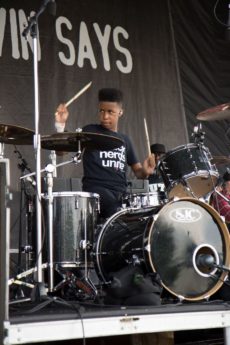 I wanted to make sure this film felt cinematic. I knew that the majority of the film would take place off-stage, and I wanted the mundane moments and settings to be as appealing and dynamic as the performances in the film. In the past, I’ve done a good bit of the camerawork on my films, but I this film to be led by its cinematography. I worked with two exceptionally talented cinematographers, Ethan Palmer and Hillary Spera. Often our process involved me aligning and re-aligning the objective of what they were covering in a scene as events developed, and then they would be able to operate freely within those parameters in finding the shots. The look and coverage in the film comes from this collaboration of dual-consciousnesses. Myself focusing on what’s happening and how it relates to other scenes we’ve shot or hope to shoot, and them focusing on the images; all of us freed up not to have to think much about the others’ task.
I wanted to make sure this film felt cinematic. I knew that the majority of the film would take place off-stage, and I wanted the mundane moments and settings to be as appealing and dynamic as the performances in the film. In the past, I’ve done a good bit of the camerawork on my films, but I this film to be led by its cinematography. I worked with two exceptionally talented cinematographers, Ethan Palmer and Hillary Spera. Often our process involved me aligning and re-aligning the objective of what they were covering in a scene as events developed, and then they would be able to operate freely within those parameters in finding the shots. The look and coverage in the film comes from this collaboration of dual-consciousnesses. Myself focusing on what’s happening and how it relates to other scenes we’ve shot or hope to shoot, and them focusing on the images; all of us freed up not to have to think much about the others’ task.
How did you establish trust with your subjects and the film’s pitch-perfect balance between inhibition and awareness?
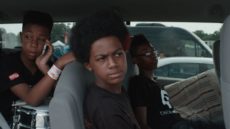 Before we made Breaking A Monster we made a short about the band, called Unlocking The Truth. We had the chance to get to know each other during that shoot. When it released, they also saw how I would present them in a film. This made it easy for them to have confidence about where I was heading with a feature, and provided familiarity from the beginning. These are prime conditions – It’s not that common to have this kind of pre-existing connection between people on opposite sides of the camera at the beginning of a documentary.
Before we made Breaking A Monster we made a short about the band, called Unlocking The Truth. We had the chance to get to know each other during that shoot. When it released, they also saw how I would present them in a film. This made it easy for them to have confidence about where I was heading with a feature, and provided familiarity from the beginning. These are prime conditions – It’s not that common to have this kind of pre-existing connection between people on opposite sides of the camera at the beginning of a documentary.
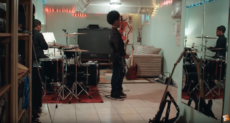 We also live in a lens-heavy environment now. Nearly everyone you know has a camera (their phone) readily accessible. We take so many more photos and moving images relative to any other point in modern history, by a staggering margin. We are all becoming desensitized to having cameras pointed at us to some degree and to seeing the images we make of each other all the time (through Facebook, Instagram, etc), and this is helping us grow more sophisticated about what we look like in other peoples images.
We also live in a lens-heavy environment now. Nearly everyone you know has a camera (their phone) readily accessible. We take so many more photos and moving images relative to any other point in modern history, by a staggering margin. We are all becoming desensitized to having cameras pointed at us to some degree and to seeing the images we make of each other all the time (through Facebook, Instagram, etc), and this is helping us grow more sophisticated about what we look like in other peoples images.
In effect, the experience of having an image made of us and seen is itself becoming a more natural experience. This camera-readiness was apparent when I was filming with the band.
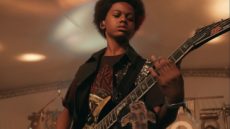 More to the point, any film that has a naturalistic feeling owes much of its essence to its editor. All films are made from jagged moments captured out of time. It’s the editor’s task to find ways of shaping and fitting them together to resemble the way we experience the world. Breaking A Monster owes a tremendous amount of how it flows and feels to its incredibly skilled and deeply talented editor, Brad Turner. He and I have worked together on several films at this point.
More to the point, any film that has a naturalistic feeling owes much of its essence to its editor. All films are made from jagged moments captured out of time. It’s the editor’s task to find ways of shaping and fitting them together to resemble the way we experience the world. Breaking A Monster owes a tremendous amount of how it flows and feels to its incredibly skilled and deeply talented editor, Brad Turner. He and I have worked together on several films at this point.
 The reserve of the film is impressive. Loaded issues, such as: exploitation of children and of race, class issues, the underbelly of fame and the commercial appropriation of art and culture pervade each scene, yet the film still appears to refrain from judgement. How did you approach the documentary thematically, i.e., what is this film about for you, and what did you consciously decide would be the best way to convey this?
The reserve of the film is impressive. Loaded issues, such as: exploitation of children and of race, class issues, the underbelly of fame and the commercial appropriation of art and culture pervade each scene, yet the film still appears to refrain from judgement. How did you approach the documentary thematically, i.e., what is this film about for you, and what did you consciously decide would be the best way to convey this?
At the start, I could see that the band was poised to launch down a strange and rapid journey. I recognized that some of what they were about to experience would provide opportunities to explore some of 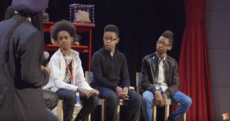 these ideas. You picked up on all the central ideas I was hoping to explore. I couldn’t be certain, since the film was designed to be observational and by definition, the outcome of a documentary is unknowable at the beginning. But I had already gotten to know the band and when I met Alan it was clear that there was going to be some kind of dynamic story that would develop between him and the band as they worked together.
these ideas. You picked up on all the central ideas I was hoping to explore. I couldn’t be certain, since the film was designed to be observational and by definition, the outcome of a documentary is unknowable at the beginning. But I had already gotten to know the band and when I met Alan it was clear that there was going to be some kind of dynamic story that would develop between him and the band as they worked together.
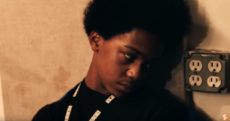 I kept all those ideas and themes alive in my consciousness throughout the making. All the issues are incredibly complex. Child-stardom is complicated, so is the history of black-artists in the predominantly white-run entertainment industry, and the questions around the intersection of art and commerce are endless. I didn’t want this film to tell its audience anything in a definitive way because that’s not how we experience these issues. If I made conclusions about the questions raised in this film, I don’t think they would feel honest when you scratched beneath the surface.
I kept all those ideas and themes alive in my consciousness throughout the making. All the issues are incredibly complex. Child-stardom is complicated, so is the history of black-artists in the predominantly white-run entertainment industry, and the questions around the intersection of art and commerce are endless. I didn’t want this film to tell its audience anything in a definitive way because that’s not how we experience these issues. If I made conclusions about the questions raised in this film, I don’t think they would feel honest when you scratched beneath the surface.
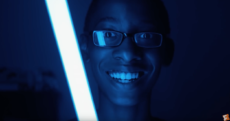 The film is actually also quite anthropological. One comes away better appreciating the fact that society has historically and consistently constructed and reconstructed the concept of what a child is, what a child needs, and what behaviors are expected of them. In this light, Breaking a Monster is imbued with still more ethical ambiguity. Were you considering such things when making it?
The film is actually also quite anthropological. One comes away better appreciating the fact that society has historically and consistently constructed and reconstructed the concept of what a child is, what a child needs, and what behaviors are expected of them. In this light, Breaking a Monster is imbued with still more ethical ambiguity. Were you considering such things when making it?
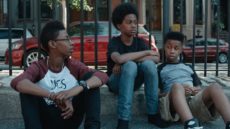 Absolutely, there is no way to look at a child star without ambiguity; they are asked to be the personification of some measure of innocence, curiosity, hope and freedom. But, for a child star to reach their audience they need to be processed by adults, their value capitalized upon and their identity is commodified. For the last half-century or more, American culture has been completely obsessed with youth – worshiping it almost – and yet the primary thing we do with youth is market it back to itself which is kind of hypocritical or at least self-defeating.
Absolutely, there is no way to look at a child star without ambiguity; they are asked to be the personification of some measure of innocence, curiosity, hope and freedom. But, for a child star to reach their audience they need to be processed by adults, their value capitalized upon and their identity is commodified. For the last half-century or more, American culture has been completely obsessed with youth – worshiping it almost – and yet the primary thing we do with youth is market it back to itself which is kind of hypocritical or at least self-defeating.
The subjects of the film are really such dynamic personalities. A fictional narrative, with all its artistic license, couldn’t have invented better characters, agreed?
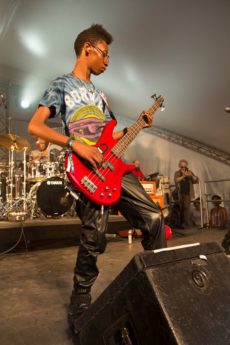 In some ways fiction ends up being a more constrained form than nonfiction. Fiction bears a cognizant responsibility to being believable; whether that means actually believable or just sympathetically believable. If it doesn’t work on either of these levels, the audience won’t care about it. Nonfiction begins from the assumption that it’s all real and therefore there is no question that it should be believed (and there are some bad nonfiction films that rely too heavily on this security). This opens up a lot of space for larger-than-life characters and for wild events to happen, and for the cliché “truth is stranger than fiction” to have some real meaning. Someone like Alan, for example, is such a tremendous character he wouldn’t work in a fictional setting. Strangely, he wouldn’t be believable.
In some ways fiction ends up being a more constrained form than nonfiction. Fiction bears a cognizant responsibility to being believable; whether that means actually believable or just sympathetically believable. If it doesn’t work on either of these levels, the audience won’t care about it. Nonfiction begins from the assumption that it’s all real and therefore there is no question that it should be believed (and there are some bad nonfiction films that rely too heavily on this security). This opens up a lot of space for larger-than-life characters and for wild events to happen, and for the cliché “truth is stranger than fiction” to have some real meaning. Someone like Alan, for example, is such a tremendous character he wouldn’t work in a fictional setting. Strangely, he wouldn’t be believable.
True, and yes some exchanges between subjects feel too brilliant to be true, i.e., the Coca Cola scene. Was there any producing on your parts, any scripting at all?
This film is a completely real depiction of what Unlocking The Truth went through in their first year dealing with the music industry. There are always interactions that happen off-camera or even on-camera that get edited out of the film, and those might reveal more communication between me and the subjects than what you see on film. 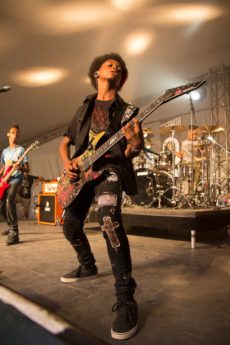 It’s primarily Brad’s skillful editing that provided the impression of a pristine world in Breaking A Monster. We made this film to feel like you are intimately peeking into the life of this band, but in reality there was a four-person (minimum) crew in the room with the people on camera. That said, there’s nothing that I would call scripting that went on – and the Coca Cola scene did just come out of nowhere.
It’s primarily Brad’s skillful editing that provided the impression of a pristine world in Breaking A Monster. We made this film to feel like you are intimately peeking into the life of this band, but in reality there was a four-person (minimum) crew in the room with the people on camera. That said, there’s nothing that I would call scripting that went on – and the Coca Cola scene did just come out of nowhere.
What made bearable some very cringe-inducing moments with these kids at the hands of the adults managing them (professionals and dilettantes alike) were the flashes of savvy within the more age-appropriate behaviors of these kids. The viewer is assured that the boys won’t entirely be victims. Still, were there any moments while filming that made you want to put your arms around these kids and give the adults in the room a timeout?
There were many moments like what you’re describing, but we made a point of keeping it to ourselves. It’s a tricky thing, making a film like this. You are invited into people’s lives and into this space to film, but you are not necessarily invited in to judge. It’s hard to describe. Despite a multiple person crew with gear; the point when it would have started to feel invasive would have been if we started expressing  opinions about what people were doing. Many of us who worked on the film continue to have relationships with the band, their families and Alan. Our relationship changed once we were no longer filming with them. Now that it’s become normal (without a camera between us all the time) we have much more candid discussions.
opinions about what people were doing. Many of us who worked on the film continue to have relationships with the band, their families and Alan. Our relationship changed once we were no longer filming with them. Now that it’s become normal (without a camera between us all the time) we have much more candid discussions.
We see some heart breaking acting-out and often feel deeply for these kids who forfeit, or are made to forfeit, much of their childhood for fame. Happily, however, they still seem surprisingly adjusted. What are your impressions in this aspect?
In the film you see them play at being rock stars, but they are not yet. Even though they are closer now, they’re still not what you could really call rock stars yet. It’s probably a good thing that they 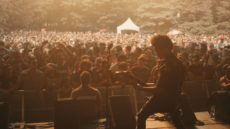 didn’t become too successful too quickly. That’s never healthy for anyone, in music or any other field. Even though they’re recording their second album and playing concerts right now, they’re also just kids in high school, and whether they like it or not, they’re much more like your kids or mine than like Justin Beiber or Miley Cyrus.
didn’t become too successful too quickly. That’s never healthy for anyone, in music or any other field. Even though they’re recording their second album and playing concerts right now, they’re also just kids in high school, and whether they like it or not, they’re much more like your kids or mine than like Justin Beiber or Miley Cyrus.
-Larissa Zaharuk
To View “Breaking A Monster” ‘s trailer here :https://www.youtube.com/watch?v=PAa4M56ctM4

